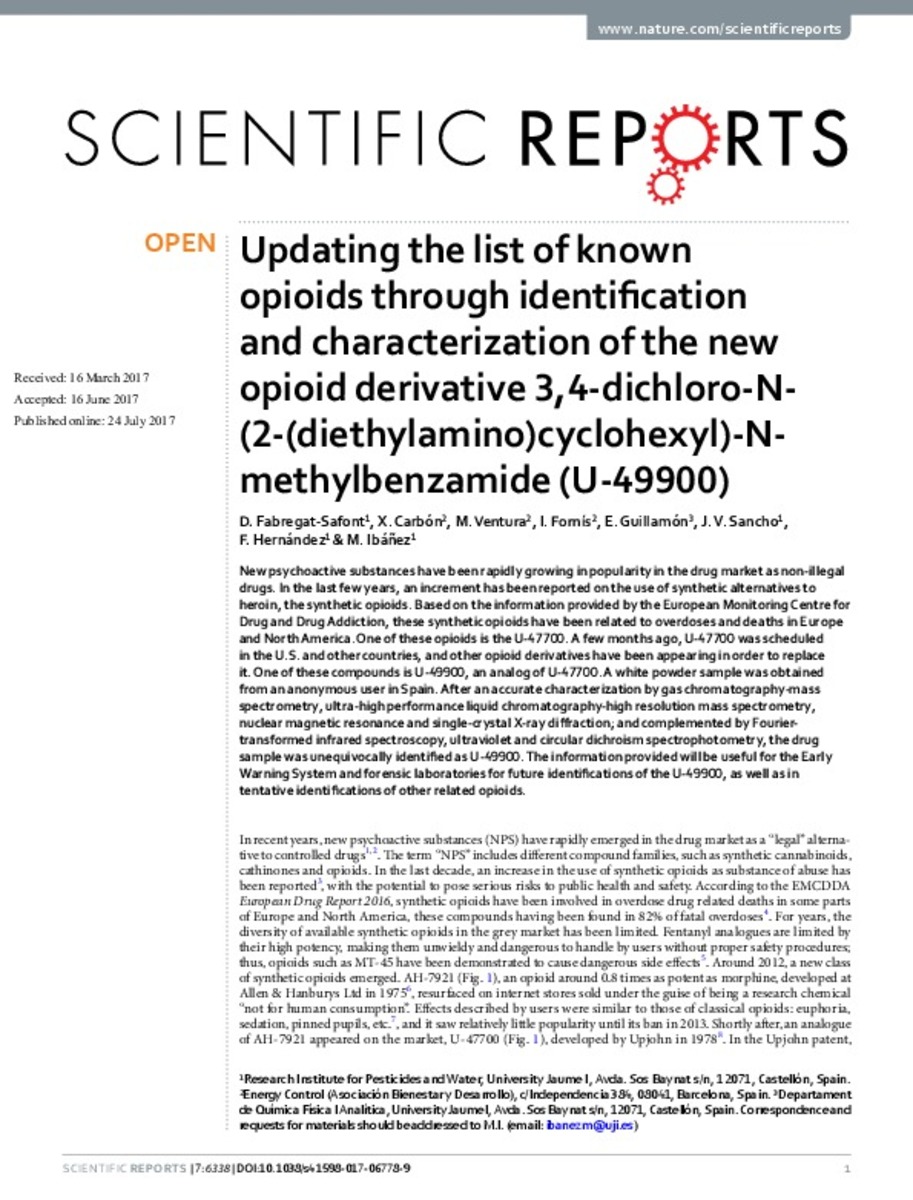Mostrar el registro sencillo del ítem
Updating the list of known opioids through identification and characterization of the new opioid derivative 3,4-dichloro-N- (2-(diethylamino)cyclohexyl)-N- methylbenzamide (U-49900)
| dc.contributor.author | Fabregat-Safont, David | |
| dc.contributor.author | Carbón, X. | |
| dc.contributor.author | Ventura, Mireia | |
| dc.contributor.author | Fornís, I. | |
| dc.contributor.author | Guillamón, Eva | |
| dc.contributor.author | Sancho, Juan V | |
| dc.contributor.author | Hernandez, Felix | |
| dc.contributor.author | Ibáñez, Maria | |
| dc.date.accessioned | 2017-12-19T16:55:47Z | |
| dc.date.available | 2017-12-19T16:55:47Z | |
| dc.date.issued | 2017 | |
| dc.identifier.citation | Fabregat-Safont, D., Carbón, X., Ventura, M., Fornís, I., Guillamón, E., Sancho, J. V., ... & Ibáñez, M. (2017). Updating the list of known opioids through identification and characterization of the new opioid derivative 3, 4-dichloro-N-(2-(diethylamino) cyclohexyl)-N-methylbenzamide (U-49900). Scientific Reports, 7(1), 6338. | ca_CA |
| dc.identifier.issn | 2045-2322 | |
| dc.identifier.issn | 2045-2322 | |
| dc.identifier.uri | http://hdl.handle.net/10234/171273 | |
| dc.description.abstract | New psychoactive substances have been rapidly growing in popularity in the drug market as non-illegal drugs. In the last few years, an increment has been reported on the use of synthetic alternatives to heroin, the synthetic opioids. Based on the information provided by the European Monitoring Centre for Drug and Drug Addiction, these synthetic opioids have been related to overdoses and deaths in Europe and North America. One of these opioids is the U-47700. A few months ago, U-47700 was scheduled in the U.S. and other countries, and other opioid derivatives have been appearing in order to replace it. One of these compounds is U-49900, an analog of U-47700. A white powder sample was obtained from an anonymous user in Spain. After an accurate characterization by gas chromatography-mass spectrometry, ultra-high performance liquid chromatography-high resolution mass spectrometry, nuclear magnetic resonance and single-crystal X-ray diffraction; and complemented by Fourier-transformed infrared spectroscopy, ultraviolet and circular dichroism spectrophotometry, the drug sample was unequivocally identified as U-49900. The information provided will be useful for the Early Warning System and forensic laboratories for future identifications of the U-49900, as well as in tentative identifications of other related opioids. | ca_CA |
| dc.format.extent | 14 p. | ca_CA |
| dc.format.mimetype | application/pdf | ca_CA |
| dc.language.iso | eng | ca_CA |
| dc.publisher | Springer Nature | ca_CA |
| dc.relation.isPartOf | Scientific Reports, 2017, vol. 7, núm. 1, p. 6338 | ca_CA |
| dc.rights | Open Access This article is licensed under a Creative Commons Attribution 4.0 International License, which permits use, sharing, adaptation, distribution and reproduction in any medium or format, as long as you give appropriate credit to the original author(s) and the source, provide a link to the Cre- ative Commons license, and indicate if changes were made. The images or other third party material in this article are included in the article’s Creative Commons license, unless indicated otherwise in a credit line to the material. If material is not included in the article’s Creative Commons license and your intended use is not per- mitted by statutory regulation or exceeds the permitted use, you will need to obtain permission directly from the copyright holder. © The Author(s) 2017 | ca_CA |
| dc.rights | Atribución 4.0 Internacional | * |
| dc.rights.uri | http://creativecommons.org/licenses/by-sa/4.0/ | * |
| dc.title | Updating the list of known opioids through identification and characterization of the new opioid derivative 3,4-dichloro-N- (2-(diethylamino)cyclohexyl)-N- methylbenzamide (U-49900) | ca_CA |
| dc.type | info:eu-repo/semantics/article | ca_CA |
| dc.identifier.doi | https://doi.org/10.1038/s41598-017-0677 | |
| dc.relation.projectID | D.F.-S., J.V.S., F.H. and M.I. acknowledge financial support from Generalitat Valenciana (Group of Excellence Prometeo II 2014/023) and from Ministerio de Economía y Competitividad in Spain (Project: CTQ2015-65603-P). D.F.-S., J.V.S., F.H. and M.I. also acknowledge NPS-Euronet (HOME/2014/JDRUG/AG/DRUG/7086), co-funded by the European Commission. This publication reflects the views only of the authors, and the European Commission cannot be held responsible for any use which may be made of the information contained therein. The authors are very grateful to the Serveis Centrals d’Instrumentació Científica (SCIC) of University Jaume I (UJI) for the use of NMR, X-ray diffractometer, FTIR and UV. They also wish to thank Cristian Vicent (SCIC), Gabriel Peris (SCIC), José Pedra (SCIC) and Florenci V. González (UJI) for skillful technical assistance and useful comments. D.F.-S. acknowledges Ministerio de Educación, Cultura y Deporte in Spain for his predoctoral grant (Grant FPU15/2033). X.C., M.V. and I.F. acknowledge the grants from Subdirecció General de Drogodependències, Departament de Salut, Generalitat de Catalunya and Plan Nacional sobre Drogas in Spain. | ca_CA |
| dc.rights.accessRights | info:eu-repo/semantics/openAccess | ca_CA |
| dc.relation.publisherVersion | https://www.nature.com/articles/s41598-017-06778-9 | ca_CA |
| dc.type.version | info:eu-repo/semantics/publishedVersion | ca_CA |
Ficheros en el ítem
Este ítem aparece en la(s) siguiente(s) colección(ones)
-
QFA_Articles [812]
Articles de publicacions periòdiques
Excepto si se señala otra cosa, la licencia del ítem se describe como: Open Access
This article is licensed under a Creative Commons Attribution 4.0 International
License, which permits use, sharing, adaptation, distribution and reproduction in any medium or
format, as long as you give appropriate credit to the original author(s) and the source, provide a link to the Cre-
ative Commons license, and indicate if changes were made. The images or other third party material in this
article are included in the article’s Creative Commons license, unless indicated otherwise in a credit line to the
material. If material is not included in the article’s Creative Commons license and your intended use is not per-
mitted by statutory regulation or exceeds the permitted use, you will need to obtain permission directly from the
copyright holder.
© The Author(s) 2017








